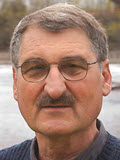
Heinz G. Stefan has approached his life and career with a seemingly infinite capacity for adaptability – always ready to find the next innovation and solve the next problem.
That ability has helped make Stefan, Dr.Ing., Dist.M.ASCE, a world leader in water resources and environmental engineering, and a worthy addition to the ASCE Class of 2016 Distinguished Members.
Much of that gift for adaptability is talent. Much of it, though, grew out of necessity.
Stefan was born in what is now the Czech Republic to Austrian parents in 1936 – just in time for World War II to completely change everything about their lives.
“How my parents were able to get through it I don’t know,” Stefan said. “I think of them as saints. They had four kids.”
Stefan’s childhood memories are crowded with barbed wire and boxcars. He spent time in a refugee camp. His family was forced to leave its home. Stefan moved to three different countries; he learned three languages.
“I think that experience made me flexible and helped me try to adjust in seeing where the problems are and what one can do about them,” said Stefan, reflecting back from his home in Minnesota, where he is a professor emeritus at the University of Minnesota.
Stefan’s family started a postwar life in Germany, and he left for France to do graduate studies in civil engineering.
“I thought the civil engineering careers were so diversified and could end up in so many different directions,” said Stefan, who declined to follow his father and older sister as high school physics teachers. “All the options seemed open. That attracted me a lot.”
In 1963, Stefan came to the United States to do research at the St. Anthony Falls Hydraulic Laboratory in Minneapolis, followed by two years of teaching at the Water Resources Institute of the Technical University in Berlin, Germany. In 1967 he would make the United States his permanent home when he accepted a civil engineering faculty position at the University of Minnesota, where he would work for 44 years.
Pioneering work factored environment into hydraulics
His research helped launch the field of ecohydraulics. He introduced environmental considerations and their analysis into hydraulic engineering design. His expertise in the design of cooling water intake and discharge facilities led to advisory roles for the electric power industry domestically, as well as in India, China, and Brazil.
His research findings on projecting potential climate change effects on lake and stream temperature and fish habitats have been influential on international climate change panels. He has also developed new tools for analyzing water quality in various water systems. In 1986, he helped design and set the standard for submerged passive intake screens are still in production today.
“Some of it was by accident,” Stefan said. “People faced some difficult problems and came to the lab and said, ‘Can you help us find a solution?’ That was difficult when there were no good tools for investigating and answering the questions.
“I would go back and ask, what are the basic principles we can apply here? And often that has worked out.”
During his University of Minnesota tenure, Stefan has advised and mentored more than 100 graduate students, of whom many have gone on to make major contributions to civil engineering. His foresight on the environment included organizing a national ASCE symposium on surface water impoundments in 1980 that addressed the interdisciplinary nature of environmental hydraulics. Stefan also has contributed to books on related subjects.
“I have been extremely fortunate,” Stefan said. “As I get older, I’m getting more and more grateful. I can’t believe all the things that have happened. I had a chance to do things and maybe make a contribution here and there. I just think it was incredible luck or destiny or whatever you want to call it. I’ve been able to do something that I’ve really liked.”
Distinguished Membership is the highest honor ASCE can bestow. It is reserved for civil engineers who have attained eminence in some branch of engineering or in related arts and sciences, including the fields of engineering education and construction.
The 2016 class of Distinguished Members will receive their honors at the ASCE 2016 Convention, Sept. 28 through Oct. 1, in Portland, OR.
Read about each of the 2016 Distinguished Members.


Congratulations on a beautiful narrative of the life and contributions of Professor Stefan. He was my advisor for my civil engineering Master’s degree at the University of Minnesota’s St. Anthony Falls Hydraulic Laboratory in the early 1990s, and to this day I consider myself fortunate to have been able to work under him. His clear-minded insight into problems and seemingly effortless ability to reduce them to simple terms was impressive. That, along with his relaxed manner and ready sense of humor made him one of the best instructors I’ve ever encountered.
Congratulations to the best professor I ever had. Your introduction to hydrology inspired me to become a water resources engineer. Your enthusiasm in and outside the classroom was the best!